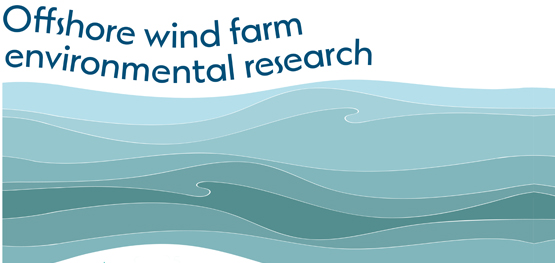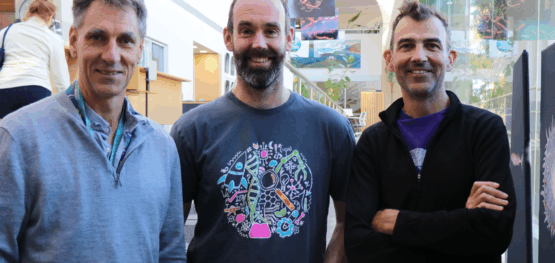Newsletter
9 September 2025
Welcome to the September Marine and Coastal Hub offshore wind farm environmental research update. This issue features hub news, plus a round up of other research activities.
The need for knowledge-sharing is a strong theme as offshore wind farm environmental research gains momentum in Australia.
The possibility of data sharing agreements was explored by hub project leader Dr Keith Hayes of CSIRO in July when he met with representatives of feasibility licence holders for offshore wind projects off Gippsland’s coast in Victoria.
We’re confident that steps in this direction will bring positive outcomes for government and industry. To continue the theme, this research update includes happenings outside the hub . . . may the winds connect us.
Please feel free to suggest items for future editions.
Hub news
Testing scenarios with Gippsland licence holders
A Marine and Coastal Hub project is developing methods and collating data required to conduct risk assessment for a suite of priority species that could be affected by offshore wind-farm development in Australia. This includes demonstrating the use of whole-of-ecosystem modelling and individual species modelling to estimate the population level impacts and cumulative risks of wind-farm development in the Bass Strait region.
The data collation and processing phase of the project is nearing completion.
“We’re close to completing an extensive data collation process for biological observations in the region,” project leader, Keith Hayes of CSIRO says. “This has included securing several data sharing agreements and preparing the data for use in modelling.”
The project team has finished developing the new BASS2 oceanographic and biogeochemical model. The model is now being validated using satellite data and sampling data from the CSIRO RV Investigator Southeast Australian Marine Ecosystem Survey voyages. A new Atlantis (ecosystem) model and a soundscape model are due to be completed by the end of the year.
In July, Dr Hayes met with Gippsland feasibility licence holders to provide an update on the project and explore opportunities for knowledge sharing. They discussed the possibility of data-sharing agreements, and the sharing of survey design, data collection and analysis methods to support the Geoscience Australia-led Renewables Environmental Research Initiative project on best practice guidelines.
“The confidential sharing of data collected by offshore wind-farm proponents would assist in the validation and improvement of models for biogeochemistry, plume dispersal, species distribution, ecosystem impact, noise impact and turbine collision risk,” Dr Hayes says.
Dr Hayes also asked licence holders for assistance in describing industry development scenarios. These include details such as the number and scale of turbines, substation platforms, export cables. Licence holders identified the need for development scenarios to reflect the Victorian Government offshore wind energy generation capacity targets.
“We’re here to provide another resource into the decision-making process,” Dr Hayes says. “While the primary research users are government decision-makers, the modelling outputs are likely to be of value to industry and will be shared on completion of the project, or earlier where parties have entered into mutual data sharing agreements with the project.
“They will offer a regional understanding of environmental values and their interactions with activities and developments between now and 2040. This includes priority species abundance and distribution, key threats to priority species to help prioritise potential impacts and impact pathways, assess mitigation options and identifying areas for monitoring.”
- Project 4.7: Development of regional modelling and risk assessments to inform offshore renewable decision-making
Welcome back Rachel Przeslawski
Dr Rachel Przeslawski has returned in a part-time capacity to help coordinate the hub’s offshore wind farm environmental research, including links with the Renewables Environmental Research Initiative. Dr Przeslawski previously led hub research on standard operating procedures and Australian Marine Park biodiversity baselines during her roles with Geoscience Australia and the New South Wales Department of Primary Industries.
National research investment
Renewables Environmental Research Initiative
Offshore wind farm research is the focus of several projects contracted under the Department of Climate Change, Energy, the Environment and Water (DCCEEW) Renewables Environmental Research Initiative (RERI). Major investments focus on examining and regulating impacts from offshore renewable activities on cetaceans, examining impacts and addressing knowledge gaps on birds, and addressing knowledge gaps for sharks and rays. Other projects focus on collision risk, seabed mapping, survey and data standards, and regulation. The hub will continue to work with DCCEEW to ensure efficiencies between the hub and RERI programs.
- Geoscience Australia RERI projects on seabed mapping and benthic survey guidelines and data standards
Events
AMSA2025
Offshore wind presentations at the Australian Marine Sciences Association 2025 conference held in July covered social as well as environmental perspectives.
Rachel Przeslawski outlined potential environmental impacts of floating offshore wind farms. Floating structures are likely to be required in NSW and have different potential impacts to the more common bottom-fixed foundations. She also spoke of the urgent need for national coordination of environmental research projects related to offshore wind energy.
Harrison Carmody of the University of Western Australia demonstrated the capacity of the Shared Analytic Framework for the Environment (SAFE) to conduct predictive habitat mapping with open and restricted data collected following the Findable, Accessible, Interoperable and Reusable (FAIR) data principles. This study of Bunbury declared area is the first to evaluate potential offshore wind farm infrastructure impacts on benthic habitats in Western Australia.
Miriam Lacharite of the Institute for Marine and Antarctic Studies at the University of Tasmania outlined a national assessment of interacting ecological, social, economic, and regulatory factors that influence the siting and monitoring of offshore infrastructure.
Laura Griffiths of Griffith University described how elements of marine spatial planning – governance integration, stakeholder participation, and knowledge integration – can rapidly be deployed to achieve greater social and environmental acceptability for offshore wind development.
Kourosh Khoshelham of the University of Melbourne outlined a collaborative, tech-enabled initiative to develop a standardised ecological monitoring framework for offshore wind in Australia.
Jessica Harvey of HiDef Aerial Surveying provided an overview of the potential impacts of offshore wind farms on marine mammals and discussed challenges in risk assessment and management.
Danielle Smith of the University of Queensland reviewed key legislation, policy, and commitments related to climate change and offshore renewables to conduct a comparative analysis of international case studies.
ACOWE symposium highlights technical challenges
Sessions at the ACOWE (Australian Centre for Offshore Wind Energy) Technical Symposium 2025 – Day 3 of the Gippsland New Energy Conference (GNEC25) – highlight the diverse technical challenges under scrutiny. More than 20 speakers are presenting talks related to the environment, engineering and logistics at the event at Federation University, Churchill, Victoria, on 11 September.
Talks on the marine environment include pile driving noise and impacts on marine mammals, seabirds and seals, and fisheries. Hub project leader Keith Hayes of CSIRO is providing an update on the assessment of cumulative impacts on priority species from new and existing maritime activities in Bass Strait. Peter Walsh and Rachel Przeslawski of the University of Tasmania are giving a presentation about establishing a trusted environmental data and information supply chain to support impact modelling.
Other sessions cover logistics (port strategies and infrastructure, cable risks); offshore engineering (geotechnical considerations, characterising carbonate sediments, foundation and anchor design, modelling seabed-structure interactions); and metocean and hydrodynamics (wave climate, trends and variability of wind density, wave and current loads and machine-based learning for metocean risk assessment).
Hub co-leader Alan Jordan is moderating the concluding panel discussion on the synthesis of research and development needs.
Australian Wind Energy 2025
Australian Wind Energy 2025 drew more than 8000 delegates to Melbourne in July for two days of dialogue and innovation showcases. Keynote addresses underscored the central role of wind energy, equity, and collaboration in shaping a resilient future. Strategic summits ranged from environmental assessments and planning frameworks to offshore wind complexities and First Nations partnerships. Panel discussions emphasised the need for earned trust, transparent data, and inclusive processes to secure social licence and accelerate progress.
- A post event report is available on the Australian Wind Energy 2026 website.
Asia Pacific Wind Energy Summit
The Asia Pacific Wind Energy Summit hosted by the Wind Energy Council is to be held in Melbourne on 16–18 September.
Reports
AMCS report on offshore wind decision-making
The Australian Centre for Offshore Wind Energy (ACOWE) and the Biodiversity Council (BC) in collaboration with The Australian Marine Conservation Society (AMCS) have released the report: Improving decision-making in relation to offshore wind: Priority knowledge and decision support needs for Australia. The 12-page report calls for offshore wind development in Australia to be guided by independent research, inclusive engagement and robust governance to ensure sustainable and equitable outcomes for communities and marine life. An accompanying document addresses questions on potential offshore wind benefits, the development process, threats to marine life, the state of knowledge, and the AMCS position on offshore wind farm development.
Global wind energy market report
The Global Wind Energy Council (GWEC) represents more than 1500 companies, organisations and institutions in more than 80 countries, including manufacturers, developers, component suppliers, research institutes, national wind and renewables associations, electricity providers, finance covers industry performance and a pathway to accelerated growth. It includes GWEC market intelligence data.


